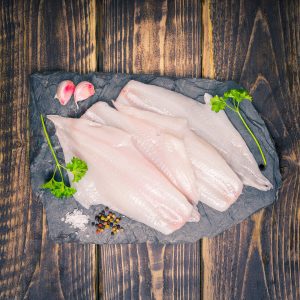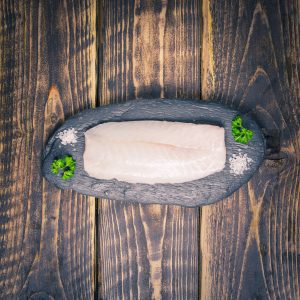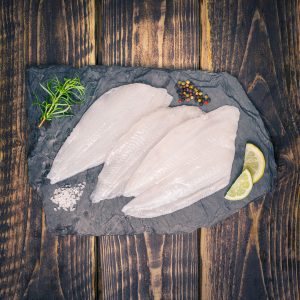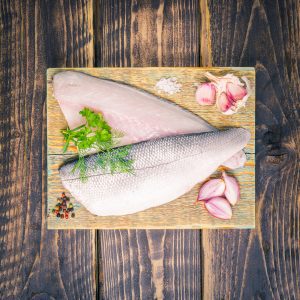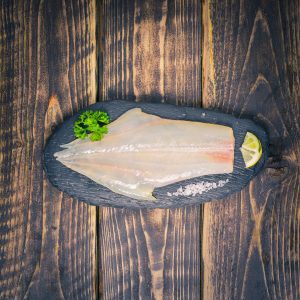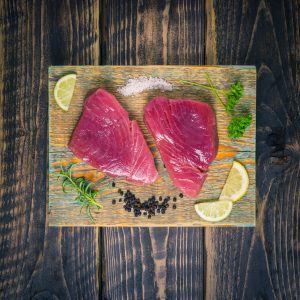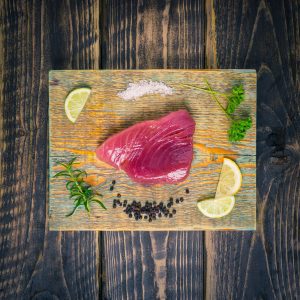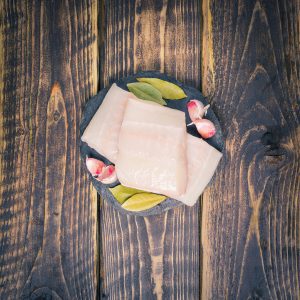Highly prized for their delicate texture and sweet taste, scallops are often considered the exclusive preserve of high-end restaurant menus. But think again – because cooking scallops is easy as long as you treat them gently. With no bones or skin to deal with, the job couldn’t be simpler.
WHAT ARE SCALLOPS?
With two beautiful convexly ridged shells, scallops are bivalve molluscs of the Pectinidae family, just like clams, mussels and oysters. The great scallop that is familiar to our shores is the king scallop or Pecten maximus.
The cold water shellfish live buried in the surface layer of soft seabeds, such as sand mud and gravel, and filter feed on plankton and detritus. Our king scallops are harvested off the north-west coast of Scotland.
Most scallops are hermaphrodites and spawn twice a year. The edible part of the scallop is the pale muscle, used to open and close the scallop’s shells, enabling it to propel itself by expelling water, and the orange roe or coral.
When resting on the seabed and feeding, the scallop shell opens up to two centimetres and that’s when the mantle, with thousands of tentacles, is visible. The scallop has a ring of eyes all around the shell to improve sensory ability and detect predators.
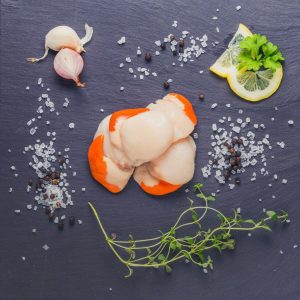
Scallops become fully mature at about three years old, when they are about 90mm in length. Spawning takes place in the warmer months, from May to August, and a three-year-old can produce between 15 and 21 million eggs each year.
When considering sustainability, choose dive-caught scallops or dredge-caught scallops from Marine Stewardship Council (MSC) certified fisheries.
With a delectable taste and juicy texture, the muscle is round and tender when cooked, with a touch of sweetness and briny saltiness. When cooked properly, scallops are smooth and tender and will melt in your mouth.
The quality of scallops from UK waters is excellent, either pale pink or light beige with a soft texture.
Historically, the scallop shell is an icon of femininity – think of Botticelli’s The Birth of Venus – and the scallop shape has early Christian connotations, often incorporated into the baptismal font of medieval churches as a symbol or birth and fertility.
WHAT’S AVAILABLE?
King scallops and queen scallops are the most commonly available in the UK and the differences between king and queen include size, taste and texture.
King scallops are often sold with the roe attached and have a sweet, delicate flavour and meaty texture. They are also known as coquilles saint-jacques and the pilgrim scallop, which goes back to the fact that the scallop was found in great numbers on the coast of Galicia in Spain and was an emblem for medieval pilgrims who travelled to Santiago de Compostela.
Meanwhile queen scallops are usually sold as meat only and are actually a different species and much smaller, only growing to about half the size of king scallops. Known as queenies, they are eaten raw or cooked in a pan with a good persillade of parsley and garlic or shallots and flambéed.
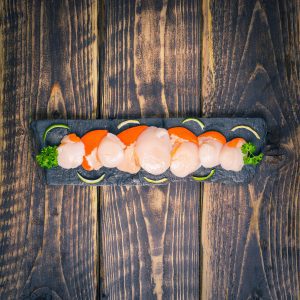
ARE SCALLOPS GOOD FOR YOU?
High in protein and low in calories, scallops are packed with omega-3 fatty acids, magnesium, potassium and B12, all helping to maintain a healthy nervous system, as well as tryptophan, an amino acid that aids sleep. The nutrients in scallops promote cardiovascular health and provide protection against colon cancer.
Per 100g steamed scallops
Energy 118kcal
Fat 1.4g (of which saturated fat 0.4g)
Protein 23.2g
Rich in vitamin B12, phosphorus, selenium and zinc
HOW DO YOU COOK SCALLOPS?
The answer is simple – quickly. Seared in a hot pan, scallops are deliciously sweet and tender and need very little fat or added flavour. Just don’t overcook the delicate shellfish or it will become rubbery.
The best plan is to fully prep the rest of your meal in advance, then you’ll need just four minutes to cook the scallops – and serve them immediately.
If the scallops are mushy to the touch, they’re undercooked, but if they’re firm, they’re overcooked. You’re looking for a springiness to the touch and opaque flesh; achieve both and you have a perfectly cooked scallop.
The scallop shell is an icon of femininity – think of Botticelli’s The Birth Of Venus – and the scallop shape has early Christian connotations
With a little bit of kitchen know-how, you can enjoy king scallops at their best. A good tip is to slice the scallop into two thinner discs, which helps by providing more uniform cooking. It’s strongly recommended for bigger scallops.
Chefs agree that the best way to cook scallops is to pan fry them. If the side muscle is still intact, remove it from each scallop, pat them dry, and season with salt and pepper. Heat olive oil or butter in a pan and cook the scallops for two minutes on each side.
Don’t overcrowd the pan and aim for a caramelised crust and a slightly translucent centre.
Alternatively, think about poaching, steaming, baking, grilling or coating scallops in breadcrumbs and deep frying.
Scallops pair well with garlic, chilli, fennel seeds and ginger, as well as bacon, chorizo and cured meats.
Don’t be scared to use the roe, or coral, when cooking king scallops. As Hugh Fearnley-Whittingstall and Nick Fisher enthuse in The River Cottage Fish Book (A&C Black, 2007) when discussing cooking scallops with roe:
“Plump and orange and in rude health, the coral is delicious – in fact, with its lightly granular, roe-like texture, it is complementary to the white muscle meat. The two should be cooked together, still attached, if possible – though on really big scallops it may be a good idea to separate them.”
Another plus point for scallops is that, thanks to their soft fleshy texture and mild sweet flavour, they are a favourite of even those who usually aren’t particularly fond of fish or shellfish.
SCALLOP RECIPES
The key to a perfectly cooked scallop is the cooking time, so look for king scallop recipes with minimum time on the grill or in the pan.
To hold in moisture, think about cooking en papillote in stock, water, milk or white wine.
Alternatively, match the delicacy of the scallop with the lightness of a tempura batter.
The key to a perfectly cooked scallop is the cooking time, so look for recipes with minimum time on the grill or in the pan
Scallops can, of course, be served raw or only just cooked, so consider sashimi, carpaccio or ceviche to complement the sweet tender flavour of the flesh.
In The River Cottage Fish Book, the authors say: “They are quite sweet enough to enjoy without so much as a squeeze of lemon. Though if you have it handy, a smear of wasabi or mustard, and a dash of soy, is pretty damn good.”
There’s little cooking time in Delia Smith’s recipe for scallops in the shell from her Complete Cookery Course (BBC Books, 1989) if you’re interested in pan-fried scallop recipes:
“Slice the white part of each scallop into rounds, putting the corals on one side for use later. Poach the white slices very, very gently in white wine until tender – about 10 minutes. Strain them, reserving the liquid.
“Melt 50g of butter in a saucepan, add onion and mushrooms and cook over a low heat for abut 15 minutes. Sprinkle in flour, add the scallop liquid gradually, stirring continuously to obtain a thick, smooth sauce. Add seasoning and a little more butter and cook gently for about six minutes.
“Remove the saucepan from the heat and stir in the white slices and the coral, plus cream. Heat the mixture over a gentle heat, taking great care not to let it boil. Combine breadcrumbs and parmesan. Divide the scallop mixture between four buttered scallop shells, sprinkle with breadcrumbs and cheese, add flecks of butter and brown under a pre-heated grill.”
Queen scallop recipes couldn’t be simpler – warming the scallops with garlic butter and serving them in their shells is all there is to presenting a showstopping starter.
A delicious king scallop recipe sears the scallops on a hot grill and serves the seafood with crispy bacon.
Search for these scallop recipes:
- Scallop and cucumber brochettes
- Scallops, Stornoway black pudding and dressed mixed leaves
- Grilled scallops with ’nduja butter
- Scallop ceviche
- Scallop and prawn risotto
- Ceviche of scallops and salmon
- Pan-seared scallops with tomato coulis
AND ANOTHER THING …
Wondering about the difference between clams and scallops? Clam is a common name for several kinds of bivalve molluscs, while scallop usually refers to numerous species of saltwater clams or bivalve molloscs in the Pectinidae family.
But what’s the difference when it comes to taste? While scallops have sweet and delicate flesh, they are less firm than clams. Clams have a more salty, fishy taste, with a texture that is chewier.
Meanwhile, when it comes to mussels and scallops, mussels have a mild taste of the sea with a faint mushroom-like undertone. The texture of mussels is tender and slightly chewy. Firmer than a scallop, mussels are softer than clams.



